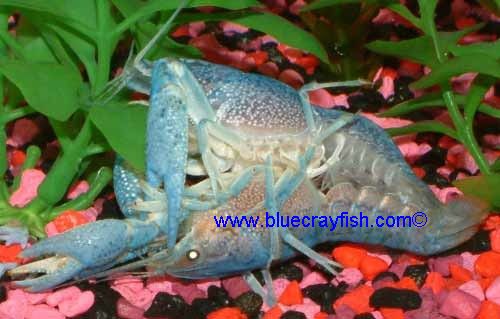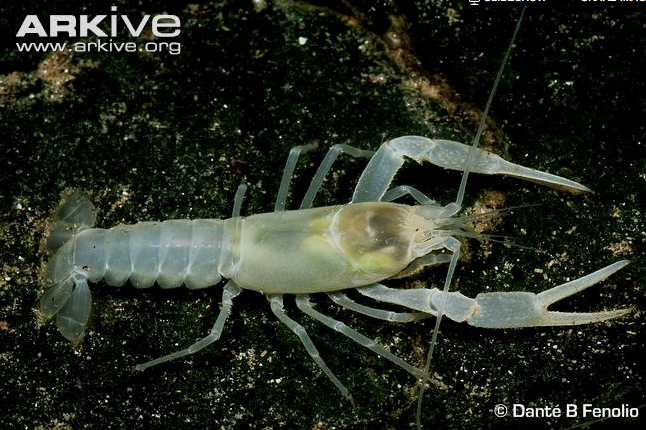Reproduction
The crayfish lives in two different morphological forms. Form I males are the males that can breed and reproduce with the female crayfish. Form II are non-reproductive males. Form I males were found between the months of May and December, which is when they sexually interact with the females. Form II males were either equal or greater in population between the months of February and November (Robison, 1996).

After the females go through mating season and oviposit, they then
attach the eggs to their abdomen and become ovigerous. This is the time
when the males molt from form I to form II. The female will carry their
eggs until they are ready to hatch (Robison, 1996).
During most of the incubation period of the crayfish, the eggs are much
darker and opaque, almost completely black. When it get’s about one week
away from its time to hatch, it will turn into a more reddish/orange
color. It will continue to get much lighter, until it is about two to
one days before hatching, and it will be completely transparent, except
for the embryo itself. When the crayfish is ready to hatch, the
surrounding membrane will rupture at the same time as the embryonic skin
is shedding. They then go through the part in their life known as “stage
one” (Tack, 1941).
The First Stage Crayfish - the first stage crayfish will grab around
with its chelae (claws) until it finds an egg stalk , soon after
hatching, and it will hang on tightly. The tips of the chelae are hooked
to make seizing the egg stalks easier. The carapace (dorsal section of
the exoskeleton) is also very rounded. Most of the time, it will be
found grasping its own egg stalk. After about twenty-four hours, the
embryonic skin loses its attachment to the telson, the posterior end of
the mother’s body. At this point, the first stage crayfish will be
attached by just its chelae. It will then molt and become a “second
stage” crayfish (Tack, 1941).
The Second Stage Crayfish - The exoskeleton still hangs onto the telson
and the egg stalks by the cast chelae. The attachment was done for the
first stage crayfish so that they did not lose attachment to their
mother at too young of an age, and during their first molting period.
Similar to the first stage crayfish, the ends of the chelae are hooked.
The first and the last appendages are not quite fully developed. The
carapace is less rounded than it was during the first stage (Tack,
1941).
The Third Stage Crayfish - The crayfish has lost its sharp chelae. At
this point, it is possible to determine the sex of the crayfish. The
first few appendages have not yet appeared though. This is the stage
when the crayfish are considered to be fully independent because they
have molted without the cast being attached to its mother. This is when
they sometimes tend to leave their mother, who provides them protection.
They will leave the mothers brood and return to it. This will happen
multiple times, each time getting longer and longer until only a few of
the young are found upon the mother (Tack, 1941).

The Fourth Stage Crayfish - The crayfish seems to even more resemble an adult, but has not yet developed its first appendages. Some of the body parts, like the pleopods are not yet fully developed and does not foreshadow what the fully matured stage will look like quite yet (Tack, 1941).
The Fifth Stage Crayfish - This is the last stage of the crayfish
development. There are vast changes made to its morphology. This is when
the gonopods (reproductive organs) of the male crayfish are developed,
and is now able to reproduce in form I. There are also visible sutures
so the
appendages are able to be easily identified (Tack, 1941).
